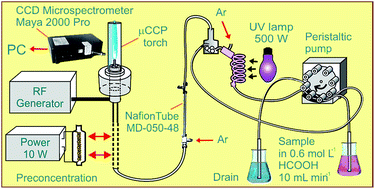A highly sensitive eco-scale method for mercury determination in water and food using photochemical vapor generation and miniaturized instrumentation for capacitively coupled plasma microtorch optical emission spectrometry†
Abstract
A highly sensitive method based on UV photochemical vapor generation capacitively coupled plasma microtorch optical emission using a low resolution microspectrometer was developed for total mercury determination in food and water. The method fulfils most of the eco-scale criteria in terms of derivatization and cost-effective miniaturized instrumentation, which are major benefits compared to cold vapor atomic fluorescence spectrometry and inductively coupled plasma optical emission spectrometry. Formic acid was the single reagent used for the extraction of Hg species from solid samples and as a reaction medium for the UV photo-induced cold vapor generation. A 200 mg lyophilized sample was subjected to ultrasonic assisted extraction in 10 mL of HCOOH 98–100% at 50 °C for 3 h, and then on-line derivatization to cold vapor was performed in 0.6 mol L−1 HCOOH. Water and food with low Hg content adjusted in HCOOH 0.6 mol L−1 underwent on-line preconcentration of Hg vapor on a gold filament microcollector. Total Hg was quantified against external standards containing Hg2+ by recording emission at 253.652 nm in a low power/Ar consumption (15 W/100 mL min−1) plasma source with a Maya2000 Pro (Ocean Optics) microspectrometer. The proposed method was compared with common laboratory approaches based on derivatization with SnCl2 and detection by inductively coupled plasma optical emission spectrometry/atomic fluorescence spectrometry, and thermal decomposition atomic absorption spectrometry. The limits of detection obtained without/with preconcentration were 3.5/0.1 ng L−1 in solution and 9/0.25 μg kg−1 in the solid, much better than those in the reference methods. The proposed method was found to be free from interference coming from multimineral matrices and organic matter, and suitable for sample analysis with various matrices as it provided a recovery of Hg without/with preconcentration of 101 ± 7%/101 ± 12% in food and 97 ± 12% in water.



 Please wait while we load your content...
Please wait while we load your content...